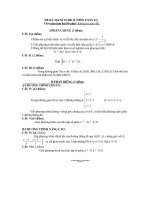10 11648 j epes 20130202 12
Bạn đang xem bản rút gọn của tài liệu. Xem và tải ngay bản đầy đủ của tài liệu tại đây (176.45 KB, 3 trang )
American Journal of Electrical Power and Energy Systems
2013; 2(2) : 41-43
Published online March 10, 2013 ( />doi: 10.11648/j.epes.20130202.12
Effective battery charging system by solar energy using
C programming and microcontroller
Mohd Tariq1,*, Sagar Bhardwaj2, Mohd Rashid3
1
M.Tech Student, Department of Electrical Engineering, Indian Institute of Technology, Kharagpur, India
B.Tech Student, Department of Electrical Engineering, Aligarh Muslim University, Aligarh , India
3
B.Tech Student, Department of Computer Science, Jamia Hamdard University, New Delhi , India
2
Email address:
(M. Tariq)
To cite this article:
Mohd Tariq, Sagar Bhardwaj, Mohd Rashid. Effective Battery Charging System by Solar Energy Using C Programming and
Microcontroller, American Journal of Electrical Power and Energy Systems. Vol. 2, No. 2, 2013, pp. 41-43.
doi:10.11648/j.epes.20130202.12
Abstract: Energy is one of the issues that is causing the most controversy as fossil fuels are the greatest pollutants and
the greatest contributors to the greenhouse effect .The increasing importance of environmental concern, fuel savings and
unavailability of power has led to the renewal of interest in renewable energies. It therefore stands to reason that developing
countries whose energy consumption rate is increasing at a very fast rate should be investigating new energy systems based
on renewable energies that do not pollute and which are inexhaustible such as the Solar system. In this paper a simple, reliable and effective solar panel charging system has been introduced consisting of a solar panel of desired size and shape.
This solar panel is integrated with an embedded system ( which contains three modules i.e. dc to ac converter, microcontroller/compiler module and charging output and a battery system).This embedded system regulates the electricity produced
(after being converted to ac from dc) between the storage battery and charging output with the help of microcontroller
which is programmed to combat the situations in presence and in absence of input supply and able to supply stored energy
at night or in unavailability of solar source.
Keywords: Renewable Energy, Solar Energy, Embedded System, Battery, Microcontroller
1. Introduction
The rapid depletion of conventional fossil fuels and environmental concern have resulted in extensive use of renewable energy sources for electrical power generation. Energy
is the convertible currency of technology. Without energy
the whole fabric of society as we know it would crumble;
the effect of a 24 hour cut in electricity supplies to a city
shows how totally dependent we are on that particularly
useful form of energy. Computers and lifts cease to function, hospitals sink to a care and maintenance level and the
lights go out. As populations grow, many faster than the
average 2%, the need for more and more energy is exacerbated. Enhanced lifestyle and energy demand rise together
and the wealthy industrialized economies which contain 25%
of the world's population consume 75% of the world's energy supply [1].
The use of new efficient photovoltaic solar cells (PVSCs)
has emerged as an alternative measure of renewable green
power, energy conservation and demand-side management
[2]. Renewable energy is the only hope and it is the area of
latest research which needs a revolution to make an effective solar panel charging system for the regulation of the
flow of current to the desired output and saving the battery
from receiving extra voltage and increasing the life.
2. Modelling of PV Cell
PV generators are neither constant voltage sources nor
current sources but can be approximated as current generators with dependant voltage sources [3]. During darkness,
the solar cell is not an active device. It produces neither a
current nor a voltage. However, if it is connected to an external supply (large voltage) it generates a current ID,
called diode current or dark current. The diode determines
the i-v characteristics of the cell. There are three different
models of PV cells generally available. A moderate model
of PV cell has been taken in this paper as shown in Figure1.
42
Mohd Tariq et al.: Effective battery charging system by solar energy using c programming and microcontroller
A small effective system comprising of four modules,
first the stepping down the dc voltage from Xv to Yv(say)
for the microcontroller process to take place, secondly inverting the dc to ac, followed by the relay action of switching and finally passing it to the microcontroller module
where it is governed as per the situation of the battery of
the module as well as of the system.
4. Set Up
Figure.1. PV cell model.
The model consists of a current source ( Isc ), a diode
(D), and a series resistance (RS). As the effect of parallel
resistance Rp is negligible, it has been omitted in this
model[4].
PV arrays are built up with combined series/parallel
combinations of PV solar cells, which are usually represented by a simplified equivalent circuit model such as the
one given in Fig. 1 and/or by an equation as in (1)
VL =
ln
(1)
Where the symbols are defined as follows:
e: electron charge (1.602 × 10-19 C).
k: Boltzmann constant (1.38 × 10-23 J/oK).
Ic: cell output current, A.
ISC: photocurrent, function of irradiation level and junction temperature (5 A).
Io: reverse saturation current of diode (0.0002 A).
Rs: series resistance of cell (0.001 Ω).
Tc: reference cell operating temperature (20 °C).
VL: cell output voltage, V.
3. Problem Statement
The designed system will solve several of the situations
where the solar panel is shown incapable and not worthy
for the work. As the system switching the different modes
of the battery in the system and in the applied area. Here is
the general information describing the overall system, we
get the supply from the solar panel system which is step
down as per the requirement and inverted if needed which
sends us to the next level of relay where the switching
takes place as per the command of microcontroller. Considering the three situations in when solar panel is connected:
a) Firstly when the output is connected, in this case the
current flows directly to the output, once the output requirements are fulfilled, it automatically switches to the
next mode with the help of a zener diode being regulated
by microcontroller and commanded to relay, fixed to a certain level and glowing the led for the same.
b) Secondly the switched mode transferred to the charging of the battery placed inside the system for emergency
usage, follows the same function of charging and when
fully charged to the level of Zener diode given it switches
the current to the initial stage.
c) Thirdly the initial stage current not entering the system when both the stages are fulfilled prevent the further
depletion of batteries which can be caused if extra current
runs through them and increasing the life of the system.
Figure.2. Block Diagram of the Proposed System.
Here the design shows the various connections inside the
system taking place.
Input from the solar panel
Stepping down the voltage
Inverting the voltage
Relay switching the different modes as per the
American Journal of Electrical Power and Energy Systems 2013, 2(2) : 41-43
commands from microcontroller.
Micro-controller connected with the npn transistor
As soon as the battery of output is filled up the zener diode cut-off the supply and glow the respective
led.
And doing same for the system battery and glows
the led after the zener diode cut off.
And finally when both the tasks are performed it returns the supply to the input point.
43
else
{P2=0x00;//or in any other condition the supply at input
and not disturbing the system }
While (0)//when solar panel supply not connected
{ If(b==1)//system battery if charged}
{ P2=0x0f;//supplying the charged system battery output
to the output point .}
This is a simple C programming which can be written in
the microcontroller.
5. Requirements
7. Conclusion
1. Solar panel:- any solar panel as per the need and requirement.
2. A normal storage battery:- as per the model required
3. A microcontroller (atmel):- preferably atmega16L
4. A relay:- 12V/5V or as per the requirement
5. invertor :- to convert dc to ac voltage
6. voltage chopper- LM317/7805
7. LED and Zener diodes :- signifying the battery is full
and zener diode to cut off the supply.
As discussed in the paper the proposed system will be
very effective for solving several situations where the solar
panel is incapable and not worthy for the work. The proposed effective charging system can be extended to any
level, any set-up, which only involves the small embedded
kit with the three essential modules empowering the renewable energy
References
6. Microcontroller Programming
The above algorithm is the key to be built in the micro
controller which is regulating the different modes of the
charging system:
P1-input port
P2-output port
while(1)//when input supply is there from solar panel
{ If(a==1)//when output battery is not fully charged}
{ P2=0xff;//opening port for the output}
elseif(b==1)//when system battery not fully charged
{P2=0x0f;//opening supply for system battery}
elseif(a=b==0)//when both the batteries are charged
{P2=0x00;//returning the input supply to the initial point}
[1]
Fells I. The problem. In: Dunderdale J,( 1990) editor. Energy and the environment. UK: Royal Society of Chemistry.
[2]
Abu Tariq, M. Asim, Mohd Tariq (2011) “Simulink based
modeling, simulation and Performance Evaluation of an
MPPT for maximum power generation on resistive load”,
2nd International Conference on Environmental Science and
Technology,Singapore.
[3]
Khan,
B.H.,
(2006),
Renewable
energy
resources,TataMcGraw-Hill Publishing Company Limited,
New Delhi, India.
[4]
[Altas. I, A. M. Sharaf, 2007 “A photovoltaic array (PVA)
simulation model to use in Matlab Simulink GUI environment.” IEEE I-4244- 0632 -03/07.









